Lifecycle deprecated/New Methods
constructor
constructors are the basic of OOP — this is a special function that will get called whenever a new object is created. It’s very important to call a special function super in cases where our class extends any other class that also has a defined constructor. Calling this special function will call the constructor of our parent class and allow it to initialize itself. This is why we have access tothis.props only after we’ve initially called super.
As mentioned, constructors are perfect for setting up our Component — create any fields (variables starting with this.) or initialize state based on props received.
This is also the only place where you are expected to change / set the state by directly overwriting the this.state fields. In all other instances remember to use this.setState
DO
set initial state
if not using class properties syntax — prepare all class fields and bind functions that will be passed as callbacks
DON’T
cause any side effects (AJAX calls etc.)
deprecated — componentWillMount
This is a somehow special case — componentWillMount does not differ much from constructor - it is also called once only in the initial mounting life-cycle. Historically there were some reasons to use componentWillMountover constructor see this react-redux issue but please keep in mind that the practice described there is since deprecated.
Many will be tempted to use this function in order to send a request to fetch data and expect the data to be available before the initial render is ready. This is not the case — while the request will be initialized before the render, it will not be able to finish before the render is called.
Additionally, with the changes to React Fiber (post React 16 beta release) this function might end up being called multiple times before the initial render is called so might result in triggering multiple side-effects. Due to this fact it is not recommended to use this function for any side-effect causing operations.
It is important to note that this function is called when using server-side-rendering while it counterpart — componentDidMount will not be called on the server but on the client in such case. So if some side-effect isdesired on the server part this function should be used as an exception.
A setState used in this function is “free” and will not trigger a re-render.
DO
update state via
this.setStateperform last minute optimization
cause side-effects (AJAX calls etc.) in case of server-side-rendering only
DON’T
cause any side effects (AJAX calls etc.) on client side
deprecated — componentWillReceiveProps(nextProps)
This function will be called in each update life-cycle caused by changes to props (parent component re-rendering) and will be passed an object map of all the props passed, no matter if the prop value has changed or not since previous re-render phase.
This function is ideal if you have a component whose parts of state are depending on props passed from parent component as calling this.setStatehere will not cause an extra render call.
Please keep in mind that due to the fact that the function is called with all props, even those that did not change it is expected the developers implement a check to determine if the actual value has changed, for example:
Due to the fact that with React Fiber (post 16 beta) this function might be called multiple times before the renderfunction is actually called it is notrecommended to use any side-effect causing operations here.
DO
sync state to props
DON’T
cause any side effects (AJAX calls etc.)
shouldComponentUpdate(nextProps, nextState, nextContext)
By default, all class based Components will re-render themselves whenever the props they receiver, their state or context changes. If re-rendering the component is computation heavy (e.g. generating a chart) or is not recommended for some performance reasons, the developer is given access to a special function which will be called in the update cycle.
This function will be called internally with next values of props, state and object. Developer can use those to verify that the change requires a re-render or not and return false to prevent the re-rendering from happening. In other case, you are expected to return true.
DO
use for increasing performance of poor performing Components
DON’T
cause any side effects (AJAX calls etc.)
call
this.setState
deprecated — componentWillUpdate(nextProps, nextState)
If the shouldComponentUpdate function is not implemented, or it decided that the component should update in this render cycle, another life-cycle function will be called. This function is commonly used to perform state and props synchronization for when parts of your state are based on props.
In cases where shouldComponentUpdate is implemented, this function can be used instead of componentWillReceiveProps as it will be called only when the component will actually be re-rendered.
Similarly to all other componentWill* functions, this function might end up called multiple times before render so it it not advised to perform side-effects causing operations here.
DO
synchronize state to props
DON’T
cause any side effects (AJAX calls etc.)
componentDidUpdate(prevProps, prevState, prevContext)
This function will be called after render is finished in each of the re-render cycles. This means that you can be sure that the component and all its sub-components have properly rendered itself.
Due to the fact that this is the only function that is guaranteed to be called only once in each re-render cycle it is recommended to use this function for any side-effect causing operations. Similarly to componentWillUpdateand componentWillReceiveProps this function is called with object-maps of previous props, state and context, even if no actual change happened to those values. Because of that developers are expected to manually check if given value changed and only then perform various update operations:
DO
cause side effects (AJAX calls etc.)
DON’T
call
this.setStateas it will result in a re-render
An exception to the above rule is updating the state based on some DOM property which can be only computed once a component has re-rendered (e.g. position / dimensions of some DOM nodes). Please take extra care to prevent against updating if the value did not in fact change as it might result in a render loop.
componentDidCatch(errorString, errorInfo)
A new addition in React 16 — this life-cycle method is special in way that it can react to events happening in the child component, specifically to any uncaught errors happening in any of the child components.
With this addition you can make your parent-element handle the error by — for example — setting the error info in state and returning appropriate message in its render, or logging to reporting system, e.g.:
When an error happens, the function will be called with:
errorString — the
.toString()message of the errorerrorInfo — an object with a single field
componentStackwhich represent the stack trace back to where the error occured, e.g.:
componentDidMount
This function will be called only once in the whole life-cycle of a given component and it being called signalizes that the component — and all its sub-components — rendered properly.
Since this function is guaranteed to be called only once it is a perfect candidate for performing any side-effect causing operations such as AJAX requests.
DO
cause side effects (AJAX calls etc.)
DON’T
call
this.setStateas it will result in a re-render
An exception to the above rule is updating the state based on some DOM property which can be only computed once a component has re-rendered (e.g. position / dimensions of some DOM nodes). Please take extra care to prevent against updating if the value did not in fact change as it might result in a render loop.
componentWillUnmount
Use this function to “clean up” after the component if it takes advantage of timers (setTimeout, setInterval), opens sockets or performs any operations we need to close / remove when no longer needed.
DO
remove any timers or listeners created in lifespan of the component
DON’T
call
this.setState, start new listeners or timers
Component cycles
There are multiple reasons a component might re-render, and in each of them different functions are called allowing the developer to update certain parts of the Component.
Component creation
The first cycle is the creation for component, which usually happens the first time a component is encountered in the parsed JSX tree:
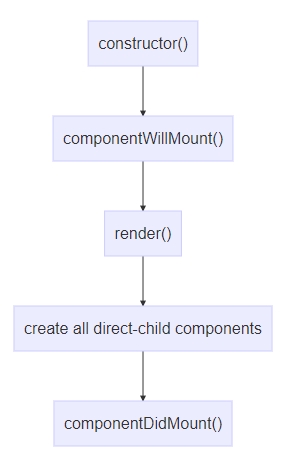
Component re-rendering due to re-rendering of the parent component
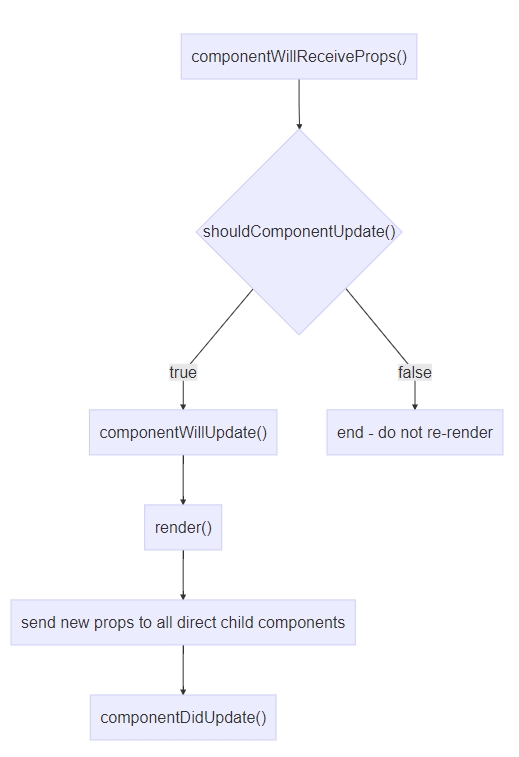
Component re-rendering due to internal change (e.g. a call tothis.setState())
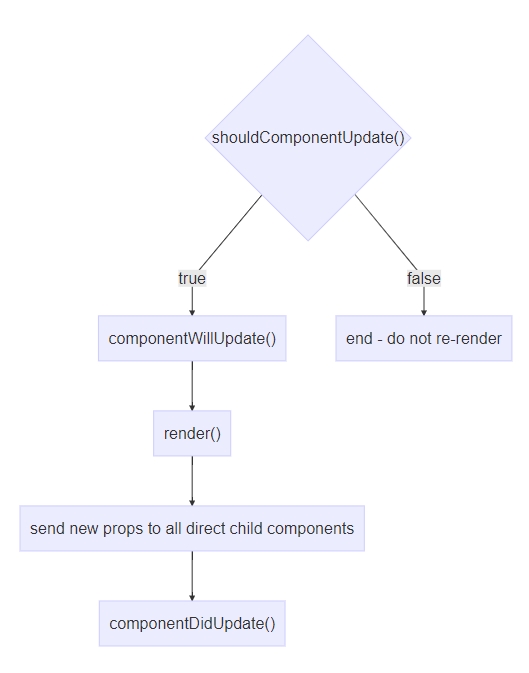
Component re-rendering due to call to this.forceUpdate
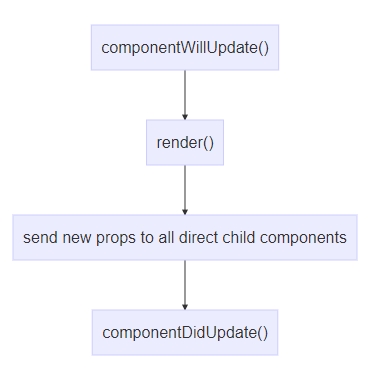
Component re-rendering due to catching an error
Introduced in React 16 as “ErrorBoundaries”. A component can define a special layer which can catch errors and provide a new life-cycle method — componentDidCatch - which allows developers to provide self-repair actions for recovery or graceful handling of errors.
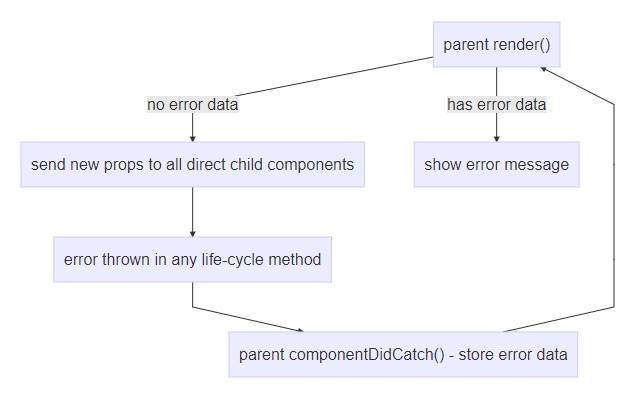
Last updated
Was this helpful?